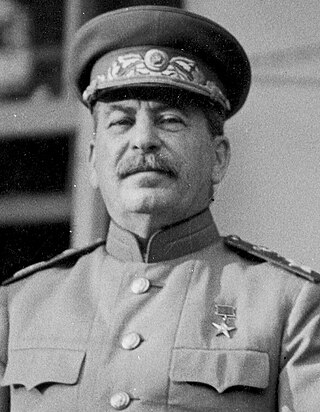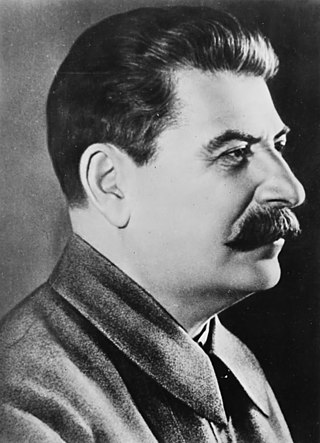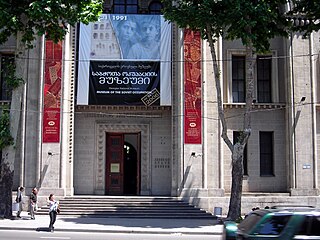
The Joseph Stalin Museum is a museum in Gori, Georgia dedicated to the life of Joseph Stalin, the leader of the Soviet Union, who was born in Gori. The museum retains its Soviet-era characteristics.

The Joseph Stalin Museum is a museum in Gori, Georgia dedicated to the life of Joseph Stalin, the leader of the Soviet Union, who was born in Gori. The museum retains its Soviet-era characteristics.
The museum has three sections, all located in the town's central square. It was officially dedicated to Stalin in 1957. With the downfall of the Soviet Union and independence movement of Georgia, the museum was closed in 1989, but has since been reopened, and is a popular tourist attraction.

Enshrined within a Greco-Italianate pavilion is a small wooden hut, in which Stalin was born in 1878 and spent his first four years. The small hut has two rooms on the ground floor. Stalin's father Vissarion Jughashvili, a local shoemaker, rented the one room on the left hand side of the building and maintained a workshop in the basement. The landlord lived in the other room. The hut originally formed part of a neighbourhood of similar dwellings, which was cleared in Soviet times to make way for more modern housing, a square, and the museum.

The main corpus of the complex is a large palazzo in Stalinist Gothic style, begun in 1951 ostensibly as a museum of the history of socialism, but clearly intended to become a memorial to Stalin, who died in 1953. The exhibits are divided into six halls in roughly chronological order, and contain many items actually or allegedly owned by Stalin, including some of his office furniture, his personal effects and gifts made to him over the years. There is also much illustration by way of documentation, photographs, paintings and newspaper articles. The display concludes with one of twelve copies of the death mask of Stalin taken shortly after his death.
The overall impression is that of a shrine to a secular saint. [1]

To one side of the museum is Stalin's personal railway carriage. The green Pullman carriage, which is armour plated and weighs 83 tons, was used by Stalin from 1941 onwards, including his attendances at the Yalta Conference and the Tehran Conference. It was sent to the museum on being recovered from the railway yards at Rostov-on-Don in 1985.
In the aftermath of the 2008 South Ossetia war, on 24 September 2008, Georgia's Minister of Culture Nikoloz Vacheishvili announced the Stalin museum would be reorganized into the Museum of Russian Aggression in the nearest future. [2] A banner was placed at the entrance stating: "This museum is a falsification of history. It is a typical example of Soviet propaganda and it attempts to legitimise the bloodiest regime in history." [3] However, it was removed by 2017.
The Stalin Monument in the central square was removed on 25 June 2010 with plans to place it in the museum. [4] On 20 December 2012, the municipal assembly of Gori voted to put an end to plans to change the museum's content. [5] [6]
Other suggestions for a transformation include the idea of including an "exhibition about the exhibition" to highlight the many inaccuracies and falsehoods of the original presentation, a proposal made by the historian and museum director Lasha Bakradze. [7] Commentators have also suggested that, based on a comprehensive Ethics of Political Commemoration, the process of transforming the museum would require extensive public engagement to legitimize any eventual design. [8]

Joseph Vissarionovich Stalin was a Soviet revolutionary and politician who was the longest-serving leader of the Soviet Union from 1924 until his death in 1953. He held power as General Secretary of the Communist Party of the Soviet Union (1922–1952) and Chairman of the Council of Ministers of the Soviet Union (1941–1953). Stalin initially governed the country as part of a collective leadership before consolidating power to become a dictator by the 1930s. Stalin coined the term Marxism–Leninism to outline his Leninist interpretation of Marxism, also known as Stalinism.

Stalinism is the means of governing and Marxist–Leninist policies implemented in the Soviet Union (USSR) from 1927 to 1953 by Joseph Stalin. It included the creation of a one-party totalitarian police state, rapid industrialization, the theory of socialism in one country, forced collectivization of agriculture, intensification of class conflict, a cult of personality, and subordination of the interests of foreign communist parties to those of the Communist Party of the Soviet Union, which Stalinism deemed the leading vanguard party of communist revolution at the time. After Stalin's death and the Khrushchev Thaw, a period of de-Stalinization began in the 1950s and 1960s, which caused the influence of Stalin's ideology to begin to wane in the USSR.

Gori is a city in eastern Georgia, which serves as the regional capital of Shida Kartli and is located at the confluence of two rivers, the Mtkvari and the Liakhvi. Gori is the fifth most populous city in Georgia. Its name comes from the Georgian word gora (გორა), meaning "heap", "hill", or "mountain".

Stalinist architecture, mostly known in the former Eastern Bloc as Stalinist style or Socialist Classicism, is the architecture of the Soviet Union under the leadership of Joseph Stalin, between 1933 and 1955. Stalinist architecture is associated with the Socialist realism school of art and architecture.

The March 1956 demonstrations in the Georgian SSR were a series of protests against Nikita Khrushchev's de-Stalinization policy, which shocked Georgian supporters of Stalinist ideology. The center of the protests was the republic's capital, Tbilisi, where spontaneous rallies to mark the third anniversary of Stalin's death and to protest Khrushchev's denunciation of Stalin commencing on 4th March quickly evolved into an uncontrollable mass demonstration and rioting which paralyzed the city. Soon, political demands such as the change of the central government in Moscow and calls for the independence of Georgia from the Soviet Union appeared.
Neo-Stalinism is the promotion of positive views of Joseph Stalin's role in history, the partial re-establishing of Stalin's policies on certain or all issues, and nostalgia for the Stalinist period. Neo-Stalinism overlaps significantly with neo-Sovietism and Soviet nostalgia. Various definitions of the term have been given over the years.
The accusation that Joseph Stalin was antisemitic is much discussed by historians. Although part of a movement that included Jews and rejected antisemitism, he privately displayed a contemptuous attitude toward Jews on various occasions that were witnessed by his contemporaries, and are documented by historical sources. In 1939, he reversed Communist policy and began a cooperation with Nazi Germany that included the removal of high profile Jews from the Kremlin. As dictator of the Soviet Union, he promoted repressive policies that conspicuously impacted Jews shortly after World War II, especially during the anti-cosmopolitan campaign. At the time of his death, Stalin was planning an even larger campaign against Jews. According to his successor Nikita Khrushchev, Stalin was fomenting the doctors' plot as a pretext for further anti-Jewish repressions.

The Remembrance Day for the Victims of Political Repression is an annual day when victims of political repression in the Soviet Union are remembered and mourned across the Russian Federation.

Dimitri Bakradze was a Georgian scholar who authored several influential works in the history, archaeology and ethnography of Georgia and the Caucasus.

Simon Arshaki Ter-Petrosian, better known by his nom de guerre of Kamo, was an Old Bolshevik revolutionary and an early companion to Soviet leader Joseph Stalin.

The Museum of the Soviet Occupation is a history museum in Tbilisi, Georgia, documenting the seven decades of the Soviet rule in Georgia (1921–1991) and dedicated to the history of the anti-occupational, national-liberation movement of Georgia, to the victims of the Soviet political repressions throughout this period. It was established on May 26, 2006. The museum is a part of the Georgian National Museum (GNM).

Grigol Vashadze is a Georgian politician, diplomat and a former member of the Cabinet of Georgia in the capacity of the Minister for Culture, Heritage Preservation and Sport (2008) and Minister for Foreign Affairs of Georgia (2008–2012). He is currently a member of Parliament of Georgia.

The 1907 Tiflis bank robbery, also known as the Erivansky Square expropriation, was an armed robbery on 26 June 1907 in the city of Tiflis in the Tiflis Governorate in the Caucasus Viceroyalty of the Russian Empire. A Bolshevik group "expropriated" a bank cash shipment to fund their revolutionary activities. The robbers attacked a bank stagecoach, and the surrounding police and soldiers, using bombs and guns while the stagecoach was transporting money through Erivansky Square between the post office and the Tiflis branch of the State Bank of the Russian Empire. The attack killed forty people and injured fifty others, according to official archive documents. The robbers escaped with 241,000 rubles.

Perm-36 was a Soviet forced labor colony located near the village of Kuchino, 100 km (60 miles) northeast of the city of Perm in Russia. It was part of the large prison camp system established by the former Soviet Union during the Stalin era, known as the Gulag. Since 1972 the camp was designated a "strict regime" and "special regime" camp used exclusively for the incarceration of "especially dangerous state criminals", mostly Soviet dissidents.
De-Stalinization comprised a series of political reforms in the Soviet Union after the death of long-time leader Joseph Stalin in 1953, and the thaw brought about by ascension of Nikita Khrushchev to power, and his 1956 secret speech "On the Cult of Personality and Its Consequences", which denounced Stalin's cult of personality and the Stalinist political system.
The anti-Stalinist left is a term that refers to various kinds of Marxist political movements that oppose Joseph Stalin, Stalinism, Neo-Stalinism and the system of governance that Stalin implemented as leader of the Soviet Union between 1924 and 1953. This term also refers to the high ranking political figures and governmental programs that opposed Joseph Stalin and his form of communism, such as Leon Trotsky and other traditional Marxists within the Left Opposition. In Western historiography, Stalin is considered one of the worst and most notorious figures in modern history.

The Solovetsky Stone is a monument to the victims of political repression in the Soviet Union and to those who have fought and fight for freedom. It stands in Troitskaya (Trinity) Square in Saint Petersburg, near several other buildings directly related to political repression in the Soviet era—the House of Tsarist Political Prisoners; the prison and necropolis of the Peter and Paul Fortress; and the Bolshoy Dom or headquarters of the NKVD, both in the city and the surrounding Leningrad Region. Nowadays, the Stone also serves as a focus for commemorative events and for gatherings related to current human rights issues.
The Ethics of Political Commemoration is a framework that seeks to improve remembrance of the past, so that it contributes to a better future. As a moral framework, it is adapted from the Just War tradition, reflecting that remembrance is often conducted with political – and sometimes coercive – intent.
Timothy K. Blauvelt is a Professor of Soviet and post-Soviet Studies at Ilia State University in Tbilisi, Georgia and has been teaching at this university since 2011.